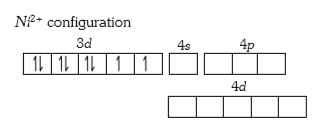Explain the following:
(i) All the octahedral complexes of Ni2+ must be outer orbital complexes.
(ii) [CoF6]3− is paramgnetic but [Co(CN)6]3− is diamagnetic .
If both assertion and reason are true and the reason is the correct explanation of the assertion.
If both assertion and reason are true but reason is not the correct explanation of the assertion.
If assertion is true but reason is false.
If the assertion and reason both are false.
The correct Answer is:B
Both assertion and reason are true but reason is not the correct explanation of assertion.

During rearrangement only one 3d-orbital may be made available by pairing the electrons. Thus, inner d2sp3 hybridization is not possible, so, only sp3d2 (outer) hybridization can occur.
Topper's Solved these Questions
- BOOK - ERRORLESSCHAPTER - COORDINATION COMPOUNDSEXERCISE - PAST YEARS QUESTIONS60videos
COORDINATION COMPOUNDS
- BOOK - ERRORLESSCHAPTER - CHEMISTRY IN EVERYDAY LIFE EXERCISE - Assertion & Reason4videos
CHEMISTRY IN EVERYDAY LIFE
- BOOK - ERRORLESSCHAPTER - ELECTROCHEMISTRYEXERCISE - Assertion & Reason11videos
ELECTROCHEMISTRY
Similar Questions
Knowledge Check
- Question 1 - Select One
Which of the following are outer orbital octahedral complexes?
A[FeF6]3−B[Fe(CN)6]3−C[Fe(CN)4]2−D[Fe(H2O)6]2+ - Question 2 - Select One
The number of unpaired electrons in the complex ion [CoF6]3− is
A3B2C4D0
[Cr(NH3)6]3+ is paramagnetic while [Ni(CN)4]2− is diamagnetic. Explain, why ?
View Solution[Co(NH3)6]3+ is diamagnetic while [CoF6]3− is_____ .
View Solution[Ni(CN)4]2− is diamagnetic while [Cr(NH3)6]3+ is paramagnetic. Explain.
View SolutionExplain the following :
[Co(NH3)6]3+ is diamagnetic, whereas [CoF6]3− is paramagnetic.View SolutionExplain [Co(NH3)6]3+ is an inner orbital complex whereas [Ni(NH3)6]2+ is an outer orbital complex.
View SolutionExplain [Co(NH3)6]3+ is an inner orbital complex whereas [Ni(NH3)6]2+ is an outer orbital complex.
View Solution

